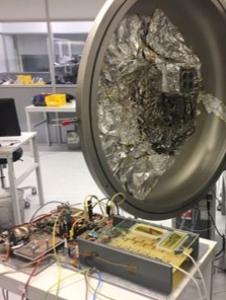VDES pre-operational demonstration for navigation augmentation and VHF maritime spectrum monitoring
Programme
GSTP
Programme Reference
GT17-113ES
Prime Contractor
SPACE NORWAY AS
Start Date
End Date
Status
Closed
Country
Norway

Objectives
This activity aims to build upon the existing space asset NORSAT-2 a pre-operational demonstration for navigation augmentation/eNAV services in the North Sea and ARCTIC sub- regions by means of VDE-SAT uplink and VDE-SAT downlink capabilities. The activity aims to use the on-going verification campaigns to establish requirements for the required waveforms and corresponding SW development for the Software-Defined Radio on-board of NORSAT-2 accordingly.
Description
The pre-operation demonstration will be used as a proof of concept towards the World-Radio Conference to demonstrate the feasibility of the VDES in a representative in the field trail. The activity will also provide the capability of monitoring the VHF maritime spectrum both from external interference sources (such as land mobile) as well as intra-system interference caused by VDES different components (such as VDE terrestrial components).
World Radio Conference 2015 has already approved digitalization of VHF communication by allocating some of the existing frequencies for a new data communications system known as the VHF Data Exchange System (VDES), this is an extension to current AIS services. As part of this new allocation, two uplink channels via satellite were approved. There is on-going work towards WRC 2019 to allocate channels for two way VHF data communications via satellite.
Several technical challenges are already identified in the use of VDE for an end-to-end applications, including:
- Services shall work under very low C/N conditions. Uplink and downlink interference, including from radio location services and land mobile services in adjacent frequency bands. Severely constrained PFD limits on downlink in a mobile propagation environment
- Latency: Get a full understanding of what can be done by 2 satellites, and which services that can be fully exploited taken into account the latency that is inherent to a 2 satellite pre-commercial service.
- Limited uplink capacity from ships: The uplink capacity is limited by propagation, regional interference and AIS priority .
- The standard only addresses the link-layer and below. The link layer ;will be part of the next revision of 2092, however this is not complete and untested. The network, transport and session layers are not addressed at all.
In the frame of this activity the following tasks shall be performenrd:
- NORSAT-2 pre-operational VDES Software (in line with application):
- Interference measurement and characterization based on existing assets
- Channel model campaign and VDES waveform revisions according to the requirements.
- Waveform and upper layer software modifications according to the requirements.
- Verification campaign and reporting
- User Segment infrastructure
- Development of required real-time SW for receiving and transmitting ASM/VDE signal with proper interface to the applications running on board of the ship for selected navigation augmentation/eNAV services.
- Procurement of user segment test terminal and deployment
- Ground Segment infrastructure
- Develop service demonstration infrastructure (SW, platform, collection of required information) for navigation augmentation/eNAV.
- Information gathering via VDES channels and processing.
- Conduct tests and service demonstrations
- Conduct demonstration and reporting on the outcome.
- Collect lessons learned and impact on complementary VDES satellite (Norsat-4).
It is proposed to change the scope and duration of the activity
The VNADS activity showed that there are multiple factors degrading a VDE-SAT downlink and that to identify and quantify these factors reference stations are required. Service quality monitoring stations will also be needed to monitor service availability and to identifying in which sub-system errors occurs in a VDE-SAT system.
In particular, a network, consisting of at least three stations, of interference and service quality monitoring stations are needed to provide capabilities to understand the mechanisms degrading a VDE-SAT downlink. Understanding these mechanisms is necessary to identify and overcome impairments of the end-to-end VDE-SAT link and to ensure further success in utilizing VDE services.
The monitoring network will help to gather data on interference environment both in long-term and short-term perspective. It will also be used to characterise propagation at 160 MHz which is key for VDE-SAT to provide a navigation signal in the future.
The network will be connected to the VDES operational centre where stations will be used as a feedback loop monitoring end-user service quality in addition to interference and propagation monitoring.
The outcome of this additional work will be a characterisation of the downlink interference environment that explains the degradation observed in VNADS and an automated service quality monitoring service.
Application Domain
Generic Technologies
Technology Domain
6 - RF Subsystems, Payloads and Technologies
Competence Domain
5-Radiofrequency & Optical Systems and Products
Initial TRL
TRL 4
Target TRL
TRL 6
Achieved TRL
TRL 5
